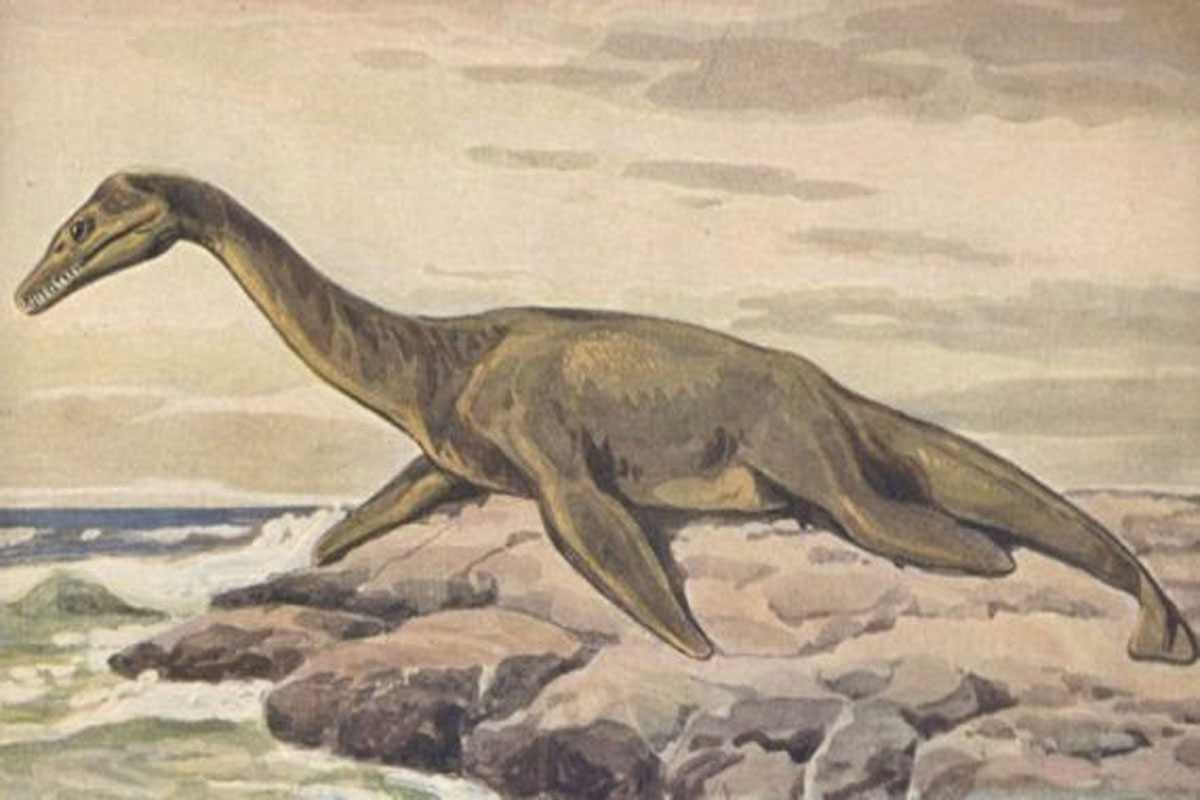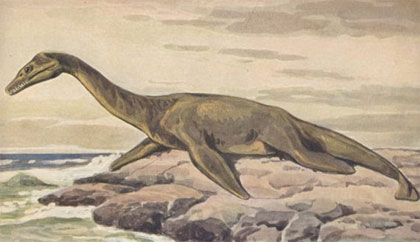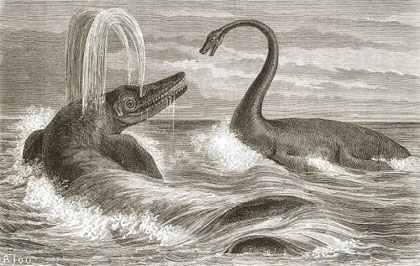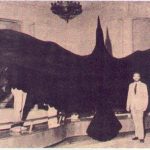
The Reasons Why Lake Monsters are Not Plesiosaurs and Never Will Be
Nick Redfern August 22, 2021
There’s one thing, more than any other, in the field of Cryptozoology that amazes me. Namely, that so many people still think that many lake monsters are surviving plesiosaurs. They’re not. At all.
So, with that said, I’ll share with you the reasons as to why plesiosaurs are not the likes of Nessie, Champ, Ogopogo and all of the rest. First, let’s have a look at the plesiosaur. Dictionary.com come right to the heart of it: “Any marine reptile of the extinct genus Plesiosaurus, from the Jurassic and Cretaceous periods, having a small head, a long neck, four paddlelike limbs, and a short tail.”
That sums it up perfectly. Of course, we can’t leave things there, though. I’ll use the Loch Ness Monster as the “template” for the reason why lake monsters can’t be plesiosaurs. So, read on. First, there’s the extremely significant fact that the plesiosaur surfaced around 250 million years ago and died out around 66/65 million years ago. Plesiosaurs, the fossil record has conclusively shown, lived in saltwater environments: our planet’s oceans. Loch Ness, however, is a freshwater loch. Yes, there is evidence of the occasional plesiosaur in a freshwater environment all those millions of years ago, but the bulk of the cases are not suggestive of entire colonies of the beasts inhabiting freshwater bodies. It’s far more likely and plausible that they wandered into them and died there.
And, yes, there are both a freshwater crocodile and a saltwater crocodile. But, the comparison is meaningless without evidence that plesiosaurs were 100 percent comfortable in both freshwater and saltwater.
 Plesiosaur
Plesiosaur
Still on the matter of extinction vs. non-extinction: let’s take note of the fact that – as the fossil-record shows – there is not a single bit of evidence to suggest plesiosaurs (anywhere on the planet) survived beyond 60-plus million years ago. Yes, we have fossilized examples of plesiosaurs. But, no, they don’t date from – for example, and hypothetically – 20 million years ago, or even 5 or 1 million years ago. They all date from the precise period in which science tells us they came to an end. And even if plesiosaurs did survive – against just about all the odds conceivable – into the modern era, they could not have made their way into Loch Ness until around the end of the last Ice Age. For one simple reason: Loch Ness didn’t exist until then. Up until that time, the area (the Great Glen) was – for all intents and purposes – a vast block of ice. So, if they didn’t enter the Loch until approximately 10,000 years ago, up until that point they must have lived in the ocean waters. But, then there’s the problem of why we haven’t found any ocean-based remains of plesiosaurs dating back – for example – 13,000 or 20,000 years.
 If evidence had been found of plesiosaurs off the coast of Scotland, and just before the end of the last Ice Age, each and every one of us should be even a bit impressed. But, nope, the evidence is always tens of millions of years old. If the plesiosaur survived beyond 65 million years ago, why is the evidence to support such a scenario 100 percent absent? Because there is no evidence, that’s why. And, now, we come to the final observation on this monster-matter. Plesiosaurs, despite what some might assume, were not fish. They were reptiles. That means they had to surface to take in oxygen. Crocodiles – which, of course, are also reptiles – can remain underwater for up to around 2-hours at a time. So, keeping that in mind, how about a bit of hypothesizing? If the Nessies are plesiosaurs, then let’s say that at any given time there are around twenty of them in the loch, ranging from (a) young and small to (b) large and old. That would be a reasonable figure to ensure the continuation of a healthy herd. Let’s also say they, like crocodiles, can stay submerged, and without taking in oxygen, for up to 2-hours at a time. This means that in any one-day, each plesiosaur would have to surface around twelve times. Twenty plesiosaurs, surfacing twelve times a day (at a minimum, I should stress), would equate to 240 surfacing events every single twenty-four-hour-long period. Multiply that by a week and the figure is elevated to 1,680. Then, multiply that by fifty-two weeks in a year and the figure becomes a massive 87,360 annually.
If evidence had been found of plesiosaurs off the coast of Scotland, and just before the end of the last Ice Age, each and every one of us should be even a bit impressed. But, nope, the evidence is always tens of millions of years old. If the plesiosaur survived beyond 65 million years ago, why is the evidence to support such a scenario 100 percent absent? Because there is no evidence, that’s why. And, now, we come to the final observation on this monster-matter. Plesiosaurs, despite what some might assume, were not fish. They were reptiles. That means they had to surface to take in oxygen. Crocodiles – which, of course, are also reptiles – can remain underwater for up to around 2-hours at a time. So, keeping that in mind, how about a bit of hypothesizing? If the Nessies are plesiosaurs, then let’s say that at any given time there are around twenty of them in the loch, ranging from (a) young and small to (b) large and old. That would be a reasonable figure to ensure the continuation of a healthy herd. Let’s also say they, like crocodiles, can stay submerged, and without taking in oxygen, for up to 2-hours at a time. This means that in any one-day, each plesiosaur would have to surface around twelve times. Twenty plesiosaurs, surfacing twelve times a day (at a minimum, I should stress), would equate to 240 surfacing events every single twenty-four-hour-long period. Multiply that by a week and the figure is elevated to 1,680. Then, multiply that by fifty-two weeks in a year and the figure becomes a massive 87,360 annually.
 Even if ninety percent of the surfacing events went unnoticed or unreported (for fear of ridicule, perhaps), that would still mean in excess of 8,000 reports per year of every year. But, the fact is that the number of sightings reported per yeart at Loch Ness equates to barely a handful. And let’s say there are only around ten plesiosaurs at any particular time in the loch (rather than my suggested twenty), well, that still means a potential 43,680 cases of the animals surfacing across 365 days. Finally, there is the matter of Nessie’s famous, long neck. A study of fossilized remains of plesiosaurs has demonstrated that the animals simply were not built to raise their necks high out of the water in the proud and prominent fashion that has been attributed to the Loch Ness Monsters. And those are the reasons why there are no living plesiosaurs. Although, I wish there were!
Even if ninety percent of the surfacing events went unnoticed or unreported (for fear of ridicule, perhaps), that would still mean in excess of 8,000 reports per year of every year. But, the fact is that the number of sightings reported per yeart at Loch Ness equates to barely a handful. And let’s say there are only around ten plesiosaurs at any particular time in the loch (rather than my suggested twenty), well, that still means a potential 43,680 cases of the animals surfacing across 365 days. Finally, there is the matter of Nessie’s famous, long neck. A study of fossilized remains of plesiosaurs has demonstrated that the animals simply were not built to raise their necks high out of the water in the proud and prominent fashion that has been attributed to the Loch Ness Monsters. And those are the reasons why there are no living plesiosaurs. Although, I wish there were!
MU*





















